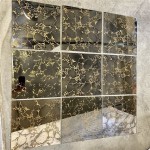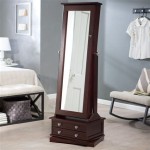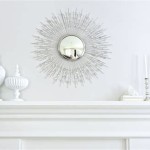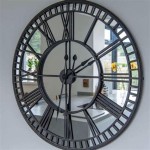Heavy Mirror Hanging Kit: A Comprehensive Guide
Hanging a heavy mirror can present a significant challenge. The weight and size of the mirror, coupled with the potential for damage to both the mirror and the wall, necessitate careful planning and the use of appropriate hardware. A heavy mirror hanging kit provides the necessary components and guidance to accomplish this task safely and effectively. This article will explore the key aspects of selecting and utilizing a heavy mirror hanging kit, focusing on the important components, weight considerations, installation techniques, and safety precautions.
Understanding the Components of a Heavy Mirror Hanging Kit
A typical heavy mirror hanging kit includes several essential components designed to distribute the weight of the mirror securely. These components typically consist of: D-rings or wire, heavy-duty picture hooks or cleats, wall anchors, screws, and sometimes a level. The functionality of each component is critical for ensuring the mirror remains securely affixed to the wall.
D-rings or wire are attached to the back of the mirror frame. D-rings, often made of metal, provide a sturdy anchor point for hanging. Wire, typically braided steel, offers flexibility in positioning the mirror. The strength of the D-rings or wire must be sufficient to support at least twice the weight of the mirror, providing a safety margin against potential failure.
Heavy-duty picture hooks or cleats serve as the primary point of contact between the mirror and the wall. Picture hooks are designed to grip the wall securely, while French cleats, consisting of two interlocking pieces, distribute the weight evenly across a larger surface area. The weight capacity of these hooks or cleats is a critical factor in determining the appropriateness of the kit for a specific mirror.
Wall anchors are used to reinforce the attachment of the picture hooks or cleats to the wall, particularly when mounting to drywall. Drywall alone is often insufficient to support the weight of a heavy mirror. Wall anchors provide a more secure grip by expanding within the wall cavity or biting into the drywall. Different types of wall anchors are available, including plastic anchors, metal anchors, and toggle bolts, each with varying weight capacities and installation requirements. Selecting the appropriate type of wall anchor is crucial for ensuring a stable and secure installation.
Screws are used to attach the D-rings, hooks, or cleats to the mirror frame and wall. The length and gauge of the screws must be appropriate for the thickness and material of the frame and wall. Using screws that are too short may result in a weak connection, while screws that are too long may protrude through the frame or wall, causing damage. The screws included in the kit are typically matched to the other components to ensure compatibility and optimal performance.
A level is used to ensure the mirror is hung straight. Precise leveling is essential for achieving a visually appealing and professional result. Some kits include a small bubble level, while others may require the user to provide their own. Laser levels can also be used for even greater accuracy.
Weight Considerations and Kit Selection
Determining the weight of the mirror is the first and most crucial step in selecting a heavy mirror hanging kit. The kit must be rated to support at least the weight of the mirror, and ideally, it should have a safety margin of at least 25%. Overestimating the weight capacity is always preferable to underestimating it, as this will provide an extra layer of security and reduce the risk of the mirror falling.
The weight of the mirror can often be found on a label attached to the back of the mirror or obtained from the manufacturer. If the weight is unknown, it can be estimated based on the size and thickness of the glass, as well as the material and construction of the frame. Online calculators are available that can assist with estimating the weight of glass and other materials.
Once the weight of the mirror is known, the appropriate heavy mirror hanging kit can be selected. It's important to carefully review the product specifications and weight ratings of different kits to ensure they meet the requirements of the project. Pay close attention to the weight capacity of the hooks or cleats, wall anchors, and D-rings or wire. Ensure that all components are rated to support at least the weight of the mirror.
The type of wall on which the mirror will be hung is another important consideration. Drywall, plaster, and concrete walls require different types of wall anchors. Drywall is the most common type of wall, but it is also the weakest. When hanging heavy mirrors on drywall, it is essential to use wall anchors that are specifically designed for this material. Stud finders can be used to locate the wooden studs behind the drywall, providing a more secure attachment point. Plaster walls are more durable than drywall but can be brittle and prone to cracking. Concrete walls are the strongest and require specialized anchors designed for masonry.
The size and design of the mirror frame can also influence the selection of the hanging kit. Mirrors with large or ornate frames may require additional support. French cleats, which distribute the weight evenly across a larger surface area, are often a good choice for these types of mirrors. The location of the D-rings or wire on the back of the frame can also affect the choice of hooks or cleats. Some frames may have D-rings located close together, while others may have them spaced farther apart. The hooks or cleats must be compatible with the spacing of the D-rings.
Installation Techniques and Safety Precautions
Proper installation is critical for ensuring the safety and stability of the hung mirror. It is recommended to carefully read and follow the instructions provided with the heavy mirror hanging kit. If the instructions are unclear or incomplete, consult online resources or seek assistance from a professional.
Prior to beginning the installation, gather all the necessary tools and materials. These may include a drill, screwdriver, level, stud finder, measuring tape, pencil, and safety glasses. Protect the floor and surrounding furniture with drop cloths or blankets.
Begin by determining the desired location of the mirror on the wall. Use a level and measuring tape to mark the location of the top edge of the mirror. Use a stud finder to locate any studs in the wall. If possible, mount the hooks or cleats directly to a stud for maximum support. If studs are not available, use appropriate wall anchors to reinforce the attachment.
Drill pilot holes in the wall at the marked locations. The size of the pilot holes should be slightly smaller than the diameter of the screws or wall anchors. Insert the wall anchors into the pilot holes. If using toggle bolts, fold the wings of the bolt and insert them through the hole in the wall. Once the wings are through the wall, they will spring open, providing a secure grip.
Attach the hooks or cleats to the wall using the screws provided in the kit. Make sure the hooks or cleats are securely fastened to the wall and that they are level. Use a level to verify the accuracy of the installation.
Carefully lift the mirror and position it so that the D-rings or wire engage with the hooks or cleats. Ensure that the mirror is securely supported by the hooks or cleats before releasing it. Double-check that the mirror is level and make any necessary adjustments. Consider applying felt pads to the bottom corners of the mirror frame to protect the wall from scratches.
Safety is paramount when handling heavy mirrors. Always wear safety glasses to protect your eyes from debris. Use caution when lifting and maneuvering the mirror to avoid dropping it or injuring yourself. Seek assistance from another person if the mirror is particularly heavy or unwieldy. Never attempt to hang a heavy mirror alone if you are not comfortable with the task. Periodically inspect the hanging hardware for signs of wear or damage. Tighten any loose screws and replace any damaged components immediately.
Following these guidelines and using a proper heavy mirror hanging kit will provide a secure and aesthetically pleasing installation, ensuring the longevity and safety of your displayed mirror.

Heavy Picture Mirror Hanging Kit 50 Kg

Heavy Duty Picture Mirror Hanging Kit Hard Wall Plasterboard Wood Hooks Hangers

Heavy Duty Large Picture Mirror Hanging Kit 50kg Hook D Ring Set

Hillman 50lb Professional Mirror Hanging Kit 77 Piece In The Picture Hangers Department At Com

50 Kg Heavy Duty Mirror Hanging Kit Secure Large Picture Frame Hooks Hangers Fittings For

Heavy Duty Mirror Hanging Hardware Kit With Hangers Leveling 100 Lbs

Heavy Picture Hanging Kit 40 Kg

50 Kg Heavy Duty Mirror Hanging Kit Secure Large Picture Frame Hooks Hangers Fittings For

How To Hang A Heavy Mirror C R F T Hanging Diy Home Improvement

20 Pack 50 Lbs Picture Frame Hangers Hooks With Nails Heavy Duty Plaster Wall Pro Photo Mirror Hanging Kit Com








